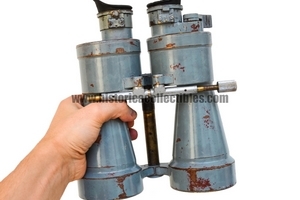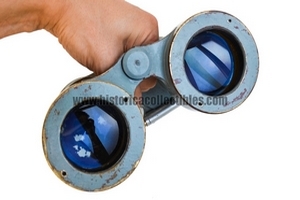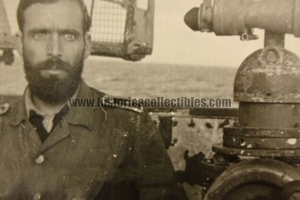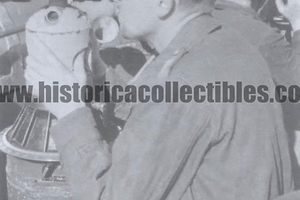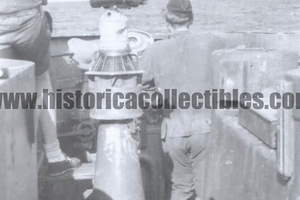Binoculars 7x50 BLC (Carl Zeiss) U.D.F., Marineblau, U-Boot Kriegsmarine, circa 1942
U.D.F. binoculars - U.Z.O. 7x50 produced by BLC, code name of the Carl Zeiss Jena company (at the disposal of the Oberkommando der Wehrmacht) in only 250 examples, in around 1942. These binoculars are commonly called U.D.F. (Unterwasser Doppel Fernrohr) or U.Z.O. (Uberwasser Ziel Optik).
It was built specifically to be installed in the turret of submarines (U-boats) belonging to the Kriegsmarine (German War Navy) and was connected via a graduated circular base to the mechanical control computer placed under the turret exactly in the control room, where once once the target was sighted, the detected coordinates were transmitted and the torpedoes were subsequently launched.
The binoculars are completely made of solid bronze and adequately built to withstand pressures of up to 30 atmospheres equivalent to 300 meters of water column, if the need arose to carry out a rapid dive which would not have allowed the personnel on deck to dismantle and transfer it inside the submarine.
The binoculars have a fixed focus, the lenses are treated with anti-reflection and the interpupillary distance is adjustable via micrometric adjustment. On the right side of the eyepiece there is a lever which, by moving it to the words "Hell or Dunkel", set the binoculars to have a clearer and more defined image, even in low light conditions, thanks to tritium particles placed on the inside the eyepiece.
This model has U.D.F. 7x50, serial number and "blc" all imprinted on the part of the left eyepiece,.
The view is clear and perfectly collimated.
Carl Zeiss takes its name from its founder, Carl Zeiss, who on November 17, 1846 chose the small city of Jena, in Thuringia, as the location for his precision optical equipment factory. Thanks to the strict quality control that Carl Zeiss imposed on its products, going so far as to personally destroy the microscopes that did not pass the tests, the newborn Zeiss became the official supplier of the University of Jena and received the gold medal of the industrial exhibition in 1861 of Thuringia as the best research instrument produced in Germany, awarded to the Stand I microscope of 1857.
In 1866 the thousandth microscope was produced and the name Zeiss became known throughout European scientific circles. Thanks to studies on the Porro prism, in 1893 Abbe patented double prism binoculars, which accentuated the perception of depth.
The mass production of Zeiss binoculars began in 1894, already at the beginning of the twentieth century more than 30,000 were made, by the beginning of the First World War the figure had risen to 500,000 and, by the end of the Second World War, 2,260,000 were produced binoculars for the civil and military market.
Thanks to studies conducted on the perception of light in low light situations, it was shown that the average dilation of the pupil in an adult is about 7 mm. For this reason, the 7x50 mm model was introduced in 1910 and remained on the market until 1917 with few changes to the materials used. In 1926, following the post-war crisis of the First World War with the Treaty of Versailles which bankrupted many important German companies, Zeiss bought the "C.P. GOERZ" and founded the Zeiss Ikon in 1926.
In 1937 Zeiss had commercial contacts and factories in more than 29 countries around the world. From '33 Zeiss acquired interest from the Nazi regime, which balanced production towards military instruments. It successfully produced binoculars with wide-angle optics for military use, pressure resistant optical systems for U-boats, periscope binoculars for targeting tanks. Furthermore, Zeiss cameras were mounted on the V2s for remote sensing operations of the English coasts.
On November 1, 1935, Zeiss, in the person of Alexander Smakula, patented a process for the treatment of optical glasses with extraordinary results in terms of light transmission. Remained a military secret until 1939, it was adopted on binoculars to reduce ghost images and internal reflections. During the Second World War, there were numerous bombings against the Zeiss factories. Jena was bombed several times by the Allies starting in 1944. Stuttgart was razed to the ground, although the Contessa-Nettel factory suffered little damage. The bombing of Dresden, in addition to devastating the city, also caused considerable damage to the Zeiss Ikon headquarters.
On April 13, 1945, American military forces entered Jena, surprising themselves that the bombing had not caused any significant damage. The main planetarium was in ruins, while the factories remained operational.


